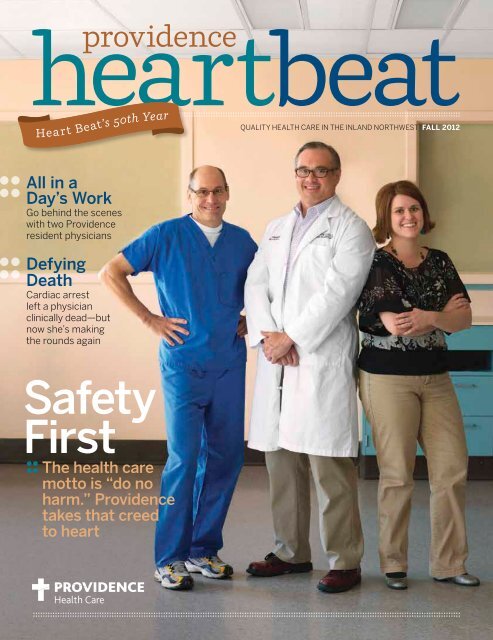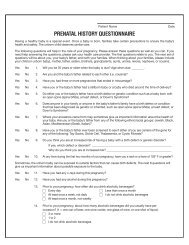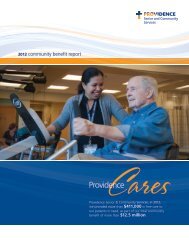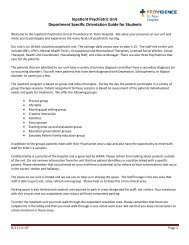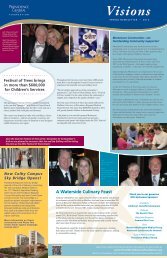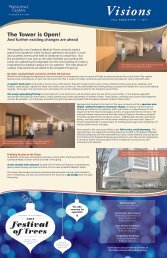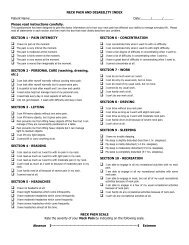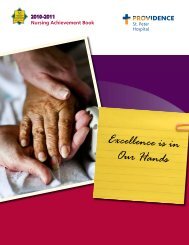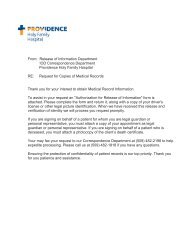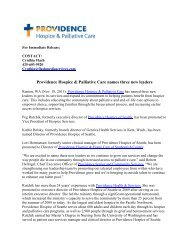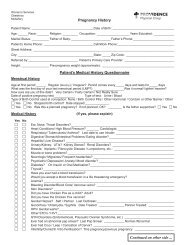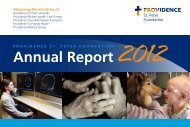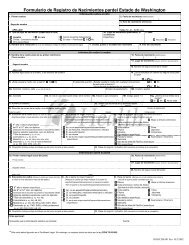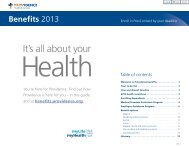Issue 3 - Fall - Providence Washington - Providence Health & Services
Issue 3 - Fall - Providence Washington - Providence Health & Services
Issue 3 - Fall - Providence Washington - Providence Health & Services
- No tags were found...
Create successful ePaper yourself
Turn your PDF publications into a flip-book with our unique Google optimized e-Paper software.
heartbeatprovidenceQuality health care in the Inland Northwest FALL 2012Heart Beat’s 50th YearAll in aDay’s WorkGo behind the sceneswith two <strong>Providence</strong>resident physiciansDefyingDeathCardiac arrestleft a physicianclinically dead—butnow she’s makingthe rounds againSafetyFirstThe health caremotto is “do noharm.” <strong>Providence</strong>takes that creedto heart
phc.orgPROVIDENCEISHOSPITALS.AND MORE.Our commitment to compassionate care keeps on growing.<strong>Providence</strong> Sacred Heart Medical Center& Children’s Hospital<strong>Providence</strong> Holy Family Hospital<strong>Providence</strong> Mount Carmel Hospital<strong>Providence</strong> St. Joseph’s Hospital<strong>Providence</strong> Medical Group<strong>Providence</strong> VNA Home <strong>Health</strong><strong>Providence</strong> DominiCare<strong>Providence</strong> St. Joseph Care Center& Transitional Care Unit<strong>Providence</strong> Adult Day <strong>Health</strong><strong>Providence</strong> Emilie Court Assisted LivingPathology Associates Medical Laboratories<strong>Providence</strong> Clinics
providenceheartbeatExecutive EditorJoe RobbMedical EditorJeff Collins, MDArt DirectorMonya MollohanManaging EditorKate VanskikeSenior Content EditorKari RedfieldPhotographerGary Matoso{FROM THE HEART}A Partnership for Better<strong>Health</strong> Care AccessCopyright 2012 © <strong>Providence</strong> <strong>Health</strong> Care.Online at phc.org. Published three times a yearby McMurry. Send comments to heartbeat@providence.org or Public Relations, P.O. Box2555, Spokane, WA 99220.Michael Wilson, Chief ExecutiveBoard of DirectorsMike Reilly, ChairGary Livingston, PhD, Vice ChairMarian Durkin, Secretary-TreasurerPatricia Butterfield, PhDRamon Canto, MDDan Dionne, MDSusanne Hartung, SPElaine HoskinPaul Larsen, MDKeith Marton, MDDean Martz, MDRob McCann, PhDSr. Judith Nilles, OPPaul PimentelCurt ShoemakerPhil StalpJim Watts, MDRon Wells<strong>Providence</strong> <strong>Health</strong> Care Eastern <strong>Washington</strong>(PHC) is the parent organization of a numberof Catholic health care ministries sponsored bythe Sisters of <strong>Providence</strong> and the DominicanSisters in Spokane and Stevens counties. Theseministries include:Hospitals<strong>Providence</strong> Sacred Heart Medical CenterSacred Heart Children’s Hospital<strong>Providence</strong> Holy Family Hospital<strong>Providence</strong> Mount Carmel Hospital (Colville)<strong>Providence</strong> St. Joseph’s Hospital (Chewelah)Other <strong>Health</strong> <strong>Services</strong>Pathology Associates Medical Laboratories<strong>Providence</strong> Adult Day <strong>Health</strong><strong>Providence</strong> DominiCare (Chewelah)<strong>Providence</strong> Emilie Court Assisted Living<strong>Providence</strong> Medical Group<strong>Providence</strong> St. Joseph Care Center &Transitional Care Unit<strong>Providence</strong> VNA Home <strong>Health</strong>PHC is part of the <strong>Providence</strong> <strong>Health</strong> & <strong>Services</strong>health care system, which spans five statesfrom Alaska to California and east to Montana.For more details, visit phc.org.Mission StatementAs people of <strong>Providence</strong>, we reveal God’s lovefor all, especially the poor and vulnerable,through our compassionate service.Core ValuesRespect • Compassion • JusticeExcellence • StewardshipSharing a common commitmentto transforminghow people in our communityaccess quality and cost-effectivehealth care, <strong>Providence</strong> <strong>Health</strong> Carehas joined forces with Group <strong>Health</strong>Cooperative to form a new jointlyowned company that represents theregion’s most comprehensive physicianorganization.Why are we forming this organization?Together, we have more than150 primary care providers to coordinateand deliver improved services inpartnership with specialists throughoutthe region. Our community willbenefit from better coordination andcommunication among caregiverswho will use the best evidence-basedmedicine for the best quality care.<strong>Providence</strong> and Group <strong>Health</strong> willwork with other health insurancecompanies to help patients acrossthe region receive more accessible,seamless and affordable care. Helpingpatients access the right kind oftreatment at the most appropriatetime and in the most appropriatesetting results in better outcomesPHOTOGRAPH BY ERIC CHAMBERLAINfor patients, less duplication and anoverall reduction in cost.Several important steps will betaken over the next year to makethis happen. Physicians who are notemployed by Group <strong>Health</strong> or <strong>Providence</strong>will be invited to affiliate withour provider group in a formal way.Their affiliation will reflect a commitmentto our goals around care coordinationand improved cost and quality.A common information system will beimplemented in 2013, which will allowseamless sharing of clinical informationto improve quality and reduceduplication. Systems for patient referraland follow-up will be focal pointsfor our success—and your experience.One of the most immediate and tangiblebenefits is that patients will notice a betterhealth care experience because the providersfrom whom they seek care have committedto practice medicine collaboratively—bydeveloping joint clinical programs, adoptingbest practices in evidence-based medicineand engaging in shared decision makingwith patients.We couldn’t be more excited about thisopportunity to better serve your healthcare needs going forward. We hope youwill join us in working to improve the overallhealth of our community.Sincerely,Michael D. Wilson,Chief ExecutiveThe <strong>Providence</strong> VisionTogether, we answer the call of everyperson we serve: Know me, care forme, ease my way.<strong>Fall</strong> 2012 Heart Beat ● 3
{contents}FALL 2012, Volume 50, No. 3On the cover: Craig Fagan, Dr. Jeff Liles and MariesaDurrant are among many hospital employees helpingto ensure patient safety is top of mind. Read more onpage 18. Photo by Gary Matoso.123 From the Heart<strong>Providence</strong> is creating a partnership to provide even better access to healthcare for all of the Inland Northwest.5 MailbagA reader talks about the remarkable recovery of Masin Hawkins, a teen whoreceived a lifesaving heart transplant and who was featured in Heart Beat.66 InsiderSpokane Valley will benefit from a new medical park, and we share your options for minimally invasive surgery.8 <strong>Health</strong>y LivingTear out and save a tipsheet with steps for preventing falls, get a free medicationcard, and try out our recipe for tasty pork tenderloin.10 Children’s <strong>Health</strong> One family shares how <strong>Providence</strong> provides expert pediatric cardiac surgerywith exceptional compassion.1412 Cardiac reportBut I can’t ask that! Answers to post-heart surgery questions that you maybe too embarrassed to ask.2414 All in a Day’s WorkGet an inside, behind-the-scenes look at a day in the life of two<strong>Providence</strong> resident physicians.18 First Do No HarmFrom falls to infections to many things in between, <strong>Providence</strong>’s clinicalexperts are creating solutions to potential patient risks during hospitalstays. It’s clinical excellence at its best.24 Defying DeathCardiac arrest left physician and researcher Katherine Tuttle, MD,lifeless. But prompt CPR and her commitment to health enabled a full,and unprecedented, comeback.2828 sustainable effortsWith the help of Green Teams, <strong>Providence</strong> hospitals are saving energyand reducing waste.30 FOUNDATIONA 4-month-old receives a hearing device, thanks to Foundation donors.1032 Role ModelA high school student turns a homework project into an innovative andfun good deed.4 ●<strong>Fall</strong> 2012 Heart Beat
{mailbag}Living LargeFormer heart transplantpatient MasinHawkins rides a bikewith a family friend.facebook.com/<strong>Providence</strong>SacredHeartfacebook.com/<strong>Providence</strong>HolyFamilyHospitalyoutube.com/<strong>Providence</strong>Spokanetwitter.com/<strong>Providence</strong>_PHCDear Heart Beat:I thought you might be interested in a follow-up to your great story coveringevents leading up to Masin Hawkins’ heart transplant and his recovery.My family has been vacationing at Priest Lake, Idaho, with the Hawkinsfamily for 34 years. Last summer I was taking photos of all the kids swimmingand noticed Masin was having trouble because he quickly got out andsat in a chair. His mother took him back to Spokane, where he ultimatelyended up spending several weeks before receiving a heart transplant. As yourarticle documented, it was a roller-coaster ride. But the family kept reportingthat, with the caring, compassionate, outstanding professional expertiseof the hospital staff, their prayers were being answered.So, for our family and theirs, this year’s family get-together was a timefor celebration. Once again, I was taking pictures, and got this one of Masingiving my 7-year-old grandson a ride on a bicycle with a ride-along attachment.He is once again a healthy, happy teenager, ready to move on with hislife. And all thanks to the staff at <strong>Providence</strong> Sacred Heart Medical Center—and the family who made possible the gift of a healthy heart.—Darolyn Q., Mercer Island, Wash.TAke A Polldo you know cpr?Studies show that 70 percent of peoplefeel helpless in a cardiac emergencybecause they are unsure how to performCPR. How about you? If you witnesseda person having a cardiac emergency,what would be your response?A) I’m ready and willing to do CPR and feelconfident of my skills!B) It’s been a long time since I’ve had training,but I think I would give it a try.C) I wouldn’t have the first clue what to do,so I would just call 911.Tell us your response onlineat phc.org/heartbeat. Andturn to page 24 to read theaccount of a doctor whoselife was saved when someone immediatelyadministered CPR.100+The number of people who had a bone density screening in responseto “These Bones Are Made for Walking” in the previous issue of HeartBeat. You can have a bone density screening, too, and learn your riskfor osteoporosis. Screenings at the Sacred Heart Women’s <strong>Health</strong>Center are just $15. Call for an appointment: 509-474-2400.Want to receiveHeart Beat via email?It’s easy. Just email heartbeat@providence.org with “e-magazinesign-up” as your subject line.<strong>Fall</strong> 2012 Heart Beat ● 5
{insider}Need Caring,Expert Help?Visit phc.org or call ourPhysician Referral Line at877-304-1408.The RonaldMcDonald Househelped 5-year-oldGabby LeDuc andher family.The Perfect PartnerSacred Heart Children’s Hospitalwould like to recognize RonaldMcDonald House Spokane on its25th anniversary of serving familiesin medical crisis who come toSpokane for expert care. While theChildren’s Hospital focuses on theimmediate medical needs of children,Ronald McDonald House Charitiestakes care of their parents (and siblings!),ensuring they have a comfortable place to getthe rest they need.When the LeDuc family of Kalispell, Mont.,learned that their 5-year-old daughter, Gabby,needed cancer treatment in Spokane—a fourtofive-hour drive—they needed a lot of support.Fortunately, between the Children’s Hospitaland the Ronald McDonald House, the family’sneeds were met.Gabby’s mom, Kathy, writes: “Sacred HeartHospital helped Gabby medically, but also emotionally.Sacred Heart really does cater to thechild’s heart and soul. The Ronald McDonaldHouse helped us feel like a family again; it is ourhome away from home. The staff has been wonderfuland the House is a very warm and invitingplace. I feel blessed to be able to stay here while mydaughter gets her treatments.”In addition to Ronald McDonald House servicesat Sacred Heart, the organization also serves thousandsof children in rural communities throughthe Ronald McDonald Care Mobile program. ALLof the funding for these vital services comes fromInland Northwest donors.InquireAbout OurMinimallyInvasiveSurgery<strong>Providence</strong> Sacred Heart Medical Center& Children’s Hospital’s operatingroom and staff recently welcomed anew member to its da Vinci robot family.Since beginning its surgical roboticsprogram in 2002, Sacred Heart hascontinued to make new treatmentsavailable with robotic assistance,including cardiac, gynecologic, urologic,and head and neck procedures.Because of the growing popularity ofrobotic surgery, Sacred Heart recentlypurchased its fourth machine.Benefits of minimally invasive surgeryinclude smaller incisions, reducedblood loss, less chance of infection andquicker recovery times, getting peopleback to their busy lives faster.According to Intuitive Surgical,the da Vinci robot’s maker, SacredHeart features one of the mostexperienced teams of surgeons andone of the most diverse robotics programsin the nation.To learn if your surgical needs can bemet with the help of today’s technology,visit shmc.org and search “robotics.”6 ● <strong>Fall</strong> 2012 Heart BeatROBOTICS PHOTO BY JIM VANGUNDY; MEDICAL PARK RENDERING COURTESY of Mahlum Architects
Medical Park Comingto Spokane ValleyThis fall, <strong>Providence</strong> <strong>Health</strong> Careproudly broke ground for its firstmajor facility in Spokane Valley.<strong>Providence</strong> Medical Park-Spokane Valleywill sit on 11 acres near the intersectionof I-90 and Sullivan, providing easyaccess to urgent care, outpatient surgery,imaging and laboratory services, andappointments from a variety of specialistsand primary care physicians.Two buildings are being constructedsimultaneously, totaling 126,000 squarefeet. One is a two-story facility housingurgent care, Inland Imaging and asurgery center; the other is a threestoryoffice building for primary careA new Spokane medical parkis coming soon and will helpprovide more convenientaccess to health care.Officials from the City of SpokaneValley joined <strong>Providence</strong> leadersin celebrating the construction ofa new facility to serve the growingSpokane Valley population.and specialty services such as oncologyand cardiology.<strong>Providence</strong> is investing $44 million toserve Spokane Valley residents and neighboringcommunities.Today’s patients expect to experience qualitycare in the most affordable setting, saysChief Executive Michael Wilson. <strong>Providence</strong>will achieve that through the development ofmore convenient services outside the hospitalenvironment, he says. “This is central to ourvision to answer the call of those we serve to‘Know Me, Care for Me, Ease My Way.’ ”The <strong>Providence</strong> Medical Park-SpokaneValley is expected to open in the springof 2014.Don’t LetAlcohol orDrug UseControlYour Life<strong>Providence</strong> Holy Family Hospitalis proud to offer a newinpatient medical stabilizationservice to patients withdrawingfrom alcohol or drug use.Called New Vision, the programaccepts adults (ages 18and up) who voluntarily seekcrisis intervention, assessmentand hospital admission.New Vision services are coveredby Medicaid, Medicareand most insurance plans.Participants benefit froman experienced team of hospitalists,nurses and otherhealth care professionals tooffer the best care possible.The team develops a plan fornext steps beyond dischargefrom the hospital to helpensure a successful drugandalcohol-free, healthy life.To see whether New Visionmay be right for you, call509-252-6488.90percent of patientrooms at <strong>Providence</strong>Holy Family Hospitalare private, one-bedrooms. Private patientrooms decreaseinfection and increasepatient satisfaction.<strong>Fall</strong> 2012 Heart Beat ● 7
{HEALTHY LIVING}Roasted PorkTenderloin withMustard GlazeFresh pork is 16 percent lower in fat than it was 15 yearsago, making pork tenderloin as lean as skinless chickenbreast, according to a study from the U.S. Department ofAgriculture. This delicious protein-filled dinner will fill youup and curb late-night cravings. And seasoning with freshherbs, instead of salt, cuts down on the sodium.Ingredients2 (1-pound) pork tenderloins, trimmed of fat1 large garlic clove, smashed1½ teaspoons olive oil1 large shallot, minced¼ cup Dijon mustard¾ teaspoon minced fresh thyme½ teaspoon salt, divided¼ teaspoon pepper, divided2 sweet potatoes, peeled and cut into six wedges1 pound fresh asparagus, tough ends snapped off2 teaspoons canola oil4 fresh thyme sprigsDirections1. Preheat the oven to 400 degrees. Rub pork tenderloinswith garlic; discard garlic.2. Heat olive oil in small skillet over medium heat. Addshallot and cook 2 minutes or until tender. Remove fromheat; spoon into small bowl. Stir in mustard, minced thyme,¼ teaspoon salt and 1 ⁄ 8 teaspoon pepper.3. Coat pork tenderloins with mustard mixture; place in largeroasting pan, tucking in tips.4. Arrange sweet potatoes and asparagus in pan aroundpork. Sprinkle vegetables with remaining ¼ teaspoon saltand 1 ⁄ 8 teaspoon pepper. Drizzle vegetables with canola oil.Scatter thyme sprigs over pork and vegetables.5. Roast for 25 minutes.6. Remove from oven; turn pork tenderloins and potatoes over;stir asparagus.7. Roast 15 to 20 additional minutes or until meat thermometerregisters 160 degrees.8. Remove from oven; discard thyme sprigs. Let pork tenderloinsrest 5 minutes; thinly slice. Serve with asparagus andsweet potatoes.Nutritional InformationMakes 8 servings. Nutrition information per serving:260 calories; 6 g total fat; 23 g protein; 25 g carbohydrates;65 mg cholesterol; 420 mg sodium; and 5 g dietary fiber.Know Your MedsIt’s important for you—and your care providers—to knowexactly what medications and vitamins or supplementsyou take regularly. We’ll make it easy for you. Just emailheartbeat@providence.org or call 509-474-3081 for a FREEPersonal Medication Record. Fill in the names and doses ofyour medications, then slip it into your wallet so it’s alwayshandy. It’s a simple way to prevent medication complications.8 ● <strong>Fall</strong> 2012 Heart Beat
Home, Safe HomePrevent falls with a few quick fixesAnyone can trip and take a tumble, but falls are more common inolder adults. In fact, thousands of older Americans fall in their ownhomes every year. Many of these accidents—and the potential for arelated injury—can be prevented. Here are some simple solutions:Live <strong>Health</strong>yat Any AgeFor more tips on healthy seniorliving, visit phc.org, thenchoose “<strong>Health</strong> Information.”In theBedroom• Make sure your bedsidelamp is easy to reach.• Consider having night lightsin the bedroom and hallway,especially if you get up oftenat night. Many have lightsensors that turn them onand off automatically.In theKitchen• Put the items you use mostoften within easy reach, atabout waist height.• If you need a step stool,make sure it’s sturdy andincludes a bar to hold on to.• Keep a “grabber tool”handy for reaching itemsthat are hard to get to.In theBathroom• Use a nonslip rubbermat or adhesive stripson the floor of the showeror bathtub.• Install grab bars inside thebathtub and next to thetoilet. A raised toilet seatmight also be helpful.On the Floor• If you use throw rugs, either get rid of them orsecure them with double-sided tape. They’re amajor trip hazard. The same is true for rippedcarpeting—repair or replace it.• Don’t leave shoes, books or other clutter lyingaround. Put items away so your path is clear.• Secure electrical cords and phone cords alongthe wall instead of running them across the room.If needed, have an expert install extra outlets.• Use nonskid wax if you wax your floors.On the Stairs• Fix uneven or broken stairs right away.• Make sure there are handrails on both sides of allstairways, even if your porch only has a couple ofsteps. Repair or replace handrails if they’re loose.• Install bright lighting, with switches at both the topand bottom of the stairs. If you can’t reach light fixtures,ask someone to replace burned-out bulbs.• If possible, paint a contrasting color on the topedge of every step to improve visibility.• Don’t leave items sitting on the stairway.<strong>Fall</strong> 2012 Heart Beat ● 9
{children’s health}Healing Hands,Healing HeartsPediatric cardiac surgery expertisedelivered with compassionMaliaka Hefling wasexpecting her fifth child.She’d been through thetests, doctor’s visits and other preparationsbefore and knew the routine.At week 20 of her pregnancy, shehad an ultrasound, just as she hadwith her four previous children. Itwas so routine that she took her kidsto a theme park afterward, neverexpecting the phone call she wouldget that night.Hefling was told that sheneeded to be seen the very nextday by a maternal-fetal medicinespecialist and cardiologist at<strong>Providence</strong> Sacred Heart MedicalCenter & Children’s Hospital. Thatfrightened her. Was there somethingwrong with her baby?At the appointment, the doctorssaid her baby had hypoplastic leftheart syndrome, which means theleft side of the heart—the mitralvalve, left ventricle, aortic valve andaorta—don’t develop completely.Hefling and her husband, Joe, beganlearning about this serious diagnosisand their options for treatment.Finding a Dream TeamThe Heflings met with Neil Worrall,MD, a pediatric cardiothoracic surgeonat Sacred Heart. He explainedthe hybrid procedure he and CarlGarabedian, MD, a pediatric cardiologist,would perform when thebaby was born. It would be followedby reconstructive surgery a fewmonths later.Diagnosing CongenitalHeart Disease at BirthNew parents never want to hear their child has a health problem, butdiagnosing congenital heart disease at birth is critical for making sure ababy gets treatment in time. That’s why Sacred Heart Children’s Hospitaland <strong>Providence</strong> Holy Family Hospital implemented a Critical CongenitalHeart Disease Screening Program for all babies born in their facilities.The program helps physicians identify newborns with critical congenitalheart disease, using pulse oximetry as a screening tool. Pulseoximetry is a noninvasive way to check whether there’s enough oxygencirculating in red blood cells.As a tertiary cardiac surgery center, Sacred Heart follows the recommendationsof the American Heart Association, the American Academyof Pediatrics and the American College of Cardiology in providing pulseoximetry screening of newborns.10 ● <strong>Fall</strong> 2012 Heart Beat“The staff herehas a uniquecohesiveness.Cardiologists andsurgeons workclosely with thepediatric intensivecare staff to providethe highest levelof care.”
Experts Ready —In Case NeededAll <strong>Providence</strong> hospitals have the staff, skill and experience to handle low-riskbirths as well as a built-in system for getting the most critically ill babies theappropriate level of care available at <strong>Providence</strong> Sacred Heart. To schedule atour, call your <strong>Providence</strong> hospital of choice:Sacred Heart: 509-474-2400 Mount Carmel/Colville: 509-685-5250Holy Family: 509-482-2229 St. Joseph’s/Chewelah: 509-935-8211“For Dr. Worrall, the surgerymeant a long eight-hour procedure,”Hefling says. “For us, it meant a lifetimewith our daughter Maranatha.How do you thank someone for that?”Maranatha was born in December2011, and was cared for bycardiologists, cardiac surgeons andexperts in the Neonatal IntensiveCare Unit and the Pediatric IntensiveCare Unit at Sacred HeartChildren’s Hospital. At every step oftheir journey, the family knew theywere in capable hands.“It’s clear the team really enjoyseach other and what they do,”Hefling says. “They were all veryapproachable and patient in explainingeverything, so we had a goodgrasp of what was going on. I like tocall them our Dream Team.”An Innovative ApproachHybrid cardiac surgery involvesteamwork between the cardiac surgeonand the cardiologist. In fact,this collaboration is a hallmark ofthe entire program at Sacred HeartChildren’s Hospital.“The staff here has a uniquecohesiveness,” Dr. Worrall says.“Cardiologists and surgeons workclosely with the pediatric intensivecare staff to provide the highestlevel of care.”Hybrid cardiac surgery is arelatively new offering with distinctadvantages for the treatment ofsome aspects of congenitalheart disease. One applicationin newborns is hypoplastic leftheart syndrome.With the hybrid procedure,babies don’t need to be put on theheart-lung bypass machine that’sused during open-heart surgery.Instead, the surgeon makes asmaller incision through which astent and pulmonary artery bandscan be implanted, stabilizing theflow of blood into the lungs and therest of the body. It causes less stressto fragile infants, and allows a delayin doing the more complex reconstructionprocedure required torepair the congenital defect.Sacred Heart’s hybrid surgerysuite is a state-of-the-art facilityabout twice the size of a typicaloperating room, allowing the cardiacsurgeon and the cardiologist towork in tandem. There’s also plentyof room for anesthesiology anddiagnostic equipment, includingvirtual computerized tomography(CT) and continuous 3-D imagingcapabilities to keep a close eye onthe heart.Although expertise and technologyare important, the team isequally focused on providing compassionatecare.“It’s important to us that familiesnot feel overwhelmed,” Dr. Worrallsays. “Whenever we can ease theirway, we do.”<strong>Fall</strong> 2012 Heart Beat ● 11
{cardiac report}I Can’t Ask MyDoctor That!Answers to important questionsyou might be afraid to askHave you ever sat on a doctor’s tablewith a question rolling around your gut,practically burning a hole through thatflimsy exam gown, and felt too scared to ask it?We did the hard part for you, answeringfive questions you might be too embarrassedto ask. Here are the frank answers—noblushing necessary!1. “I’ve tried to quit smokingbut can’t. Is there hope?”One of the top contributors to heart diseaseis smoking. When people quit,they reduce their risk of heart disease,lung cancer and breast cancer.Yet quitting is the single mostdifficult challenge for manypatients. After all, it’s an addictionand there’s no “magic pill.”There are many resources for smokers,including medication, hypnosis and smokingcessation counseling. But what really matters isyour personal commitment. Studies show thatunless a patient is truly motivated to kick thehabit, success is rare.To get started, set a quit date, download theNo-Smoking Contract at heart.org, and sign it infront of friends and family who will help you keepyour vow. Don’t be shy about talking to your doctorabout quitting smoking. He or she wants to help.2. “When can I havesex after a heartattack?”This is one of the mostpressing questionsafter a heart attackor bypass surgery.12 ● <strong>Fall</strong> 2012 Heart Beat
Yet, patients don’t always ask it. Untilrecently, heart experts had little researchon the subject, making it difficult to advisepatients. But this year, the American HeartAssociation released new guidelines aboutsex after a heart attack, and urged cardiologiststo discuss them with every patient.The good news? If you can handle moderateactivity like household chores without experiencingchest pain or shortness of breath, then yourheart is strong enough for sex.Talk with your doctor about cardiac rehabilitation,which strengthens your heart andrestores energy.3. “Will you know ifI don’t exercise?”While blood tests offer a preciselook at your eating habits,they reveal far less about yourexercise routine.Ultimately, lying to yourdoctors = cheating yourself.There isn’t any reason to lie toyour doctors. They want to help youachieve optimum health and prevent diseases,so it’s better to be honest with them so they canhelp you achieve healthy practices.4. “I survived, but whycan’t I shake these feelingsof depression?”Cardiologists are experts on the physical heart.But sometimes, they delve into the metaphoricalheart, too. It’scommon to feeldepressed and anxiousafter a heartattack or bypasssurgery. It’s vital thatyou seek treatmentfor depression, becausepatients who don’t are morelikely to have repeat heart attacks. You shouldn’tsuffer in silence. Talk with your doctor openly.5. “Is it possible to ‘cram’for my checkup?”It’s tempting to scarf salads and pop fish oilpills the week before a cholesterol test. But willyour cardiologist know you haven’t maintaineda healthy diet?The answer is yep—you’re busted.Your body is full of clues that help doctorspiece together a picture of your health. The mosttelling clue is a little thing called the hemoglobinA1c test, which measures the averageamount of sugar in your red blood cellsover the past 90 days.There are other clues. If youhaven’t been adhering to a diet,your cholesterol and bloodpressure levels will be proof.High-carbohydrate foodssuch as beer and chips make yourtriglycerides spike. And fastingglucose, which can signal diabetes,rises with poor eating habits.It’s temptingto scarf saladsand pop fishoil pills theweek beforea cholesteroltest ... but yourcardiologistwill know.CPR Update:Mouth-to-Mouth NotRequiredYou may have taken a CPR class back in college, but do you remember the steps? Is itmouth-to mouth and then three chest compressions? Or three breaths and one chestcompression?Fortunately, you may not have to remember at all.Research shows that a new method of resuscitation, called cardiocerebral resuscitation, iseasier to administer and more effective in responding to out-of-hospital cardiac arrest. It eliminatesthe need to blow air into the victim’s mouth, which can increase the chance for overresuscitation.The constant flow of blood to the heart and brain by performing continuous chestcompressions has been proven to minimize danger and increase survival. It also eliminatesthe concern of swapping germs or “catching” something by performing mouth-to-mouth.With the science supporting the effectiveness of compressions alone, experts hope the newguidelines will help more people will feel comfortable offering the lifesaving act of CPR.See how this new kind of CPR actually saved the life of a beloved doctor right here inSpokane. Read the full feature starting on page 24.<strong>Fall</strong> 2012 Heart Beat ● 13
5:30ALL IN ADay’sork9:009:15Get an inside, behind-the-sceneslook at a day in the life of two<strong>Providence</strong> resident physicians14 ● <strong>Fall</strong> 2012 Heart Beat6:006:157:007:308:158:30Story by Liz DeRuyterPhotos by Gary Matoso9:4510:15
Shortly aftermoving to Spokane four years ago,Marilyn Scheel found a primarycare doctor by accident. She arrivedat <strong>Providence</strong> Sacred Heart MedicalCenter & Children’s Hospitalwith a broken ankle. When sheneeded a primary care physicianfor follow-up, doctors referred herto <strong>Providence</strong> Family MedicineResidency-Spokane.The clinic, along with <strong>Providence</strong>Internal Medicine Residency-Spokane,provides clinicaltraining for new doctors. Scheelcouldn’t be happier with the treatmentshe has received from <strong>Providence</strong>.“Each of my doctors hasbeen kind and thorough,” says the65-year-old. “I’m lucky to live whereI can get great care.”The residency program offersrecent medical school graduatesthe opportunity to continue theireducation in family medicine,including a rural training track.There’s also obstetrics, sportsmedicine, internal medicine andradiology. With the support ofmedical faculty, the doctors seepatients in local community clinicsand hospitals.“The program attracts some ofthe best new doctors from acrossthe country,” says Judy Benson, MD,director of graduate medical educationat <strong>Providence</strong>. “The result isthat patients in Spokane and Stevenscounties benefit from the knowledgeof these new graduates, as well asfrom the extensive experience of ourmedical faculty members.”5:306:006:157:007:308:158:309:009:159:45<strong>Fall</strong> 2012 Heart Beat ● 15
:30:15:30:00:15:45For the medical residents, every day is filledwith the experience of a lifetime. Although nosingle day is ever typical in the life of a doctor,here’s a sample day in the life of two residents:6:30 a.m.Jonathon Anderson, MD, arrivesat the Intensive Care Unit (ICU) atSacred Heart to meet with the overnightmedical team. The doctors andstaff review patients’ conditions andtreatment plans. Dr. Anderson willbe caring for four patients today.7:00 a.m.Dr. Anderson begins rounds, personallyassessing each patient’s condition,checking diagnostic reportsand making adjustments in thetreatment plan. His first patient is a74-year-old man admitted initiallyfor myocardial infarction (heartattack) with acute heart failure, pulmonaryedema (excess fluid in thelungs) and acute kidney injury.“My goal is to reduce the excessfluid, manage his myocardial infarctionwith medication since he is apoor candidate for surgery at thistime, and wean down his ventilatorsupport enough to see if he’s able tobreathe on his own,” says the doctor.7:15 a.m.Faculty members arrive early at theFamily Medicine Residency clinic.So does second-year resident LilyWittich, MD. In her role as chiefmedical resident, she acts as a liaisonbetween the residents and faculty,attending faculty meetings, managingthe schedule for resident doctors andhandling other administrative duties.8:30 a.m.Dr. Wittich’s day shifts to her clinicalresponsibilities. She’ll be seeingpatients within the hour, and beginsreviewing patient charts.9:00 a.m.In the ICU, Dr. Anderson meetswith a pulmonologist, who is aspecialist focused on the respiratorysystem. It’s what Dr. Andersoncalls a teaching moment—the entiremedical team discusses diagnosticsand recommended treatments fortheir critically ill patients.9:05 a.m.At the primary care clinic, Dr.Wittich sees her first patient, a34-year-old developmentally disabledman from a group home.He fears a toe may be infected.Dr. Wittich uses the visit to evaluatehis overall health. “Many of mypatients have complicated medicalproblems,” she explains. “This is animportant opportunity to check ontheir well-being, evaluate medicationsand determine if there areother health concerns.”9:45 a.m.Dr. Anderson is doing rounds on hispatients again, this time accompaniedby an intensivist, which is theattending physician who specializesin the care of critically ill patients.A 65-year-old male with an extensivehistory of heart disease is in theICU with a very serious case of congestiveheart failure. The patient’smedication was changed earlier inthe day, and Dr. Anderson is monitoringhis progress.10:30 a.m.Dr. Wittich has treated threepatients in the clinic so far thismorning and now follows up onanother matter: calling a homehealth agency to arrange for heartmedicine management for one ofher patients. “She is a 75-year-oldwoman with serious blood clottingin her legs, which has traveled toher lung,” explains Dr. Wittich.“She needs to be on warfarin,which is a blood thinner, for sixmonths to treat the thrombosisand pulmonary embolism.” Butwarfarin can be dangerous if notmonitored closely, and the doctorwants to ensure her patient getsthe help she needs.MedicalEducationby theNumbers71Number of medical residentscurrently in <strong>Providence</strong>Graduate MedicalEducation programs.245Number of family medicinegraduates since the programbegan in 1972.65Percent of family medicinegraduates who remainedin the Spokane referral areato practice medicine.80Percent of family medicine“rural track” graduates whopractice in rural Northwestcommunities.22,500Number of patient visits to<strong>Providence</strong> Family MedicineResidency-Spokane.71Percent of Internal MedicineResidency graduates whoremained in the Spokane referralarea to practice medicine.16 ● <strong>Fall</strong> 2012 Heart Beat
Lily Wittich, MDJonathon Anderson, MD12:00 p.m.Dr. Anderson attends the noonconference with all the internalmedicine residents. It is anotherteaching moment in which facultyand residents discuss patient casestudies. Today, a colleague discussesan HIV patient who also has hepatitisC. Physicians and pharmaciststhroughout the Pacific Northwestjoin the teleconference.1:15 p.m.Thursday afternoons are teachingtime in the Family MedicineResidency clinic. A lecture by apsychologist in the clinic focuses ondiagnosis and treatment of depression.A resident presents a report onbipolar disorder. A cardiologist from<strong>Providence</strong> Spokane Heart Institutegives a lecture on how primary caredoctors can manage atrial fibrillation(irregular heartbeat and a frequentcause of strokes).2: 30 p.m.Some of Dr. Anderson’s four ICUpatients are improving. His firstpatient of the day is being weanedoff ventilator support.3:15 p.m.Attempts to wean Dr. Anderson’ssecond patient, a 71-year-old male,off sedation have been unsuccessfulbecause the patient is severelyagitated. He came to ICU initiallyResidentHonoredwith Award“Colville is the luckiest city in America tobe getting you,” said a card to Katrina E.Gardner, MD, then a first-year medicalresident at the Family Medicine Residencyclinic in Spokane.Dr. Gardner now is in Colville, completingher third year of resident training.It comes as no surprise to herpatients that she was selected from afield of 3,200 eligible family medicineresidents to receive the esteemedBristol-Myers Squibb Award for Excellencein Graduate Medical Education.The award’s 10 recipients represent themost outstanding family medicine residentsin the country.“Dr. Gardner is profoundly connectedwith the human experience, and her clinicalabilities are second to none,” saysGary Newkirk, MD, director of Spokane’sFamily Medicine Residency program.“The award not only honors an outstandingdoctor, but is a testament to the highlevel of care available to residents ofEastern <strong>Washington</strong>.”for ventilator management after anoperation. Dr. Anderson is givinghim medication for agitation andhopes to transition him to oral painmedications.4:45 p.m.Dr. Wittich spends the next hourcalling patients, finishing patientreports and writing prescriptions.Before leaving the clinic, she’llreview each patient’s care with herfaculty advisor.5:30 p.m.Dr. Anderson hands off the care ofhis patients to the night team. All ofhis patients made remarkable progresstoday.5:306:006:157:007:308:158:309:009:159:45<strong>Fall</strong> 2012 Heart Beat ● 17
NThe team pictured on page 21 and here havesomething in common: They are all participatingin the creation and implementation of newprocesses to keep patients safe at <strong>Providence</strong>Sacred Heart and Holy Family hospitals. Fromleft: Craig Fager, RN, ICU; Estee Wilson, RN,Emergency; Rodney Williams, RN, Emergency;Mariesa Durrant, Pharmacy.Dofirst,18 ● <strong>Fall</strong> 2012 Heart Beat
From falls to infections to many things inbetween, <strong>Providence</strong> is creating solutions todramatically reduce potential patient risks duringhospital stays. Get a glimpse of three projects thatdemonstrate our dedication to ensuring patientsafety, improving outcomes and reducing thelength of hospital stays and the associated costs.This is clinical excellence at its best.Story by Kate VanskikePhotos by Gary MatosoOHarm<strong>Fall</strong> 2012 Heart Beat ● 19
Hospitalsin the United States rank amongthe best in the world. We areaccustomed to ultrasterile environments,high-tech electronicsystems and numerous redundantprocesses, all geared towardensuring that patient safety andclinical quality are maintained atall times. Still, things sometimesdon’t go as planned, even withinthe best medical centers. Patientssometimes get infections. They fall.They develop complications whenhard-to-diagnose conditions aren’tfound early. These are the reasonswe have many state and federalagencies solely dedicated to overseeingmedical processes, workingclosely with physicians andhospital leadership to ensure thatwe deliver the best care possible inevery situation.“There is significant governmentoversight on patient safety,plus major expectations fromstate, federal and private organizationsreporting our outcomes tothe public,” says Jeff Collins, MD,chief medical executive for <strong>Providence</strong><strong>Health</strong> Care, which includesSacred Heart Medical Center &Children’s Hospital and <strong>Providence</strong>Holy Family Hospital in Spokaneand two rural hospitals in StevensCounty. “But those regulations andexpectations mean nothing, really,if the hospital leadership doesn’thave a strong desire simply to dothe right thing, every time.”He adds: “That’s what we haveat <strong>Providence</strong>—a deep commitmentto be the best. Not for the sake ofawards, though these are evidenceof our work, but so patients knowthat they are in good hands.”Geriatric HipFractures: StartingSurgery SoonerIn 2009, Sacred Heart care providersdiscovered more could be doneto improve outcomes for hip fracturepatients, so the orthopedic teamdesigned the Geriatric FractureProgram to decrease hip fracturepatients’ wait time for surgery.“Evidence-based research showsthat the faster a patient with a fracturedhip goes to surgery, the fewercomplications they have postoperatively,improving their ability toget back to everything they enjoyedbefore acquiring a fracture,” saysnurse manager Tamara Sheehan, RN.The team—which includedorthopedic trauma and anesthesiaphysicians, orthopedic traumanurses and pharmacists—designeda process to improve the flow of ahip fracture patient’s process fromadmission to the orthopedic traumaunit and through surgery. Each teammember had a key role in ensuringessential tests and treatments werecompleted as quickly as possible.“One of the most fascinatingaspects of this project was to findthat the only cost of implementationwas the time commitment of theteam members,” Sheehan says. “OurGeriatric Fracture Program couldbe duplicated in any hospital wherea department is willing to work collaborativelywith others.”RESULTS:• The length of stay for hip fracturepatients at Sacred Heart decreasedby 0.7 days, getting patients backto their normal lives sooner.• This decrease in the length of stayfor 2010 and 2011 saved $371,000in labor costs.These innovators (from left:Michelle Egan, RN, Orthopedics;Jeff Liles, MD, Care Management;and Amelia Jay, Physical Therapy)have implemented processesthat help patients recover fasterand more completely from hipfractures and other illnesses.Providingsurgeries“At <strong>Providence</strong>we have a deepcommitment to be thebest. Not for the sakeof awards, thoughthese are evidenceof our work, but sopatients know theyare in good hands.”20 ● <strong>Fall</strong> 2012 Heart Beat
forgeriatrichip fracturesASAPIS KEY.Immobility inthe ICU: GettingPatients MovingCritically ill patients are often immobilizedas a direct result of theirillness or because of the use of sedativesand pain medications. Beinginactive for a long period can causedelirium, weakness and pressureulcers, conditions that can result inlonger stays in the Intensive CareUnit (ICU) or another care unit.These conditions can also result ina decreased quality of life for thepatient after he or she returns home.“A mobility protocol that getsICU patients out of bed and walkingas early as possible, even whilethey are hooked up to a portableventilator, can decrease mortalityand improve quality of life for thepatient,” explains Mary Jo Moore,RN, nurse manager at Sacred Heart.To address those issues, theICU made changes in how patientswere weaned from their ventilators,adapted the use of certainmedications and involved physicaltherapists earlier.RESULTS:• Decreased length of stay in theICU and associated costs.• Reduction in complications relatedto prolonged ventilator use.• Improved patient, family and physiciansatisfaction.• Reduced the patient’s time on theventilator by almost a day.• Reduced the patient’s hospital stayby 1.3 days.<strong>Fall</strong> 2012 Heart Beat ● 21
Treating Sepsis:Saving LivesEvery day, patients arrive at theemergency departments with severesepsis and septic shock—an infectionthat can attack vital organsand lead to death. At Sacred Heartand Holy Family hospitals, newprotocols have produced amazingimprovements in the care of patientssuffering from this illness.“Sepsis is not a specific disease.It’s a condition resulting when alocalized infection becomes a systeminfection,” explains Jeff Liles, MD, aninternist who works solely within thehospital and nursing home settings.“It’s what people used to refer to as‘blood poisoning’.”An example is pneumonia or abladder infection that spreads fromits original site into the whole body.There will be signs that the bodyis fighting severe infection, such asdecreased blood pressure, increasedheart rate and fever.“It’s a widespread problem thatcould be easily prevented in manycases with the prompt use of antibiotics,”says Jeff Collins, MD, chief medicalexecutive for <strong>Providence</strong> <strong>Health</strong>Care. In 2011, he asked staff to developa process to address the sepsis situationand produce the results he knew<strong>Providence</strong> hospitals could achieve.What started as a small projectat Holy Family became a comprehensiveregional initiative includinga team of experts from both<strong>Providence</strong> hospitals in Spokane,comprising personnel from theemergency department, pharmacy,laboratory and nursing. With helpfrom Dr. Liles and other physicians,the team started a process to identifyand treat septic patients earlyenough to prevent long-term damageand reduce the risk of death.Tonya Dean, one of the projectleaders, is a certified Six Sigmaexpert in operational excellence,which means she uses proven methodologiesto measure outcomes andfind where improvements shouldbe made. She and others followedpatients’ experience in the emergencydepartment, reviewed their chartsand determined how long it took forthem to have the right lab work andreceive IV fluids and antibiotics.“Now,” she says, “anytime a personarrives with signs that indicate thepossibility of severe sepsis, we call thesepsis alert and expedite everything.”“We’ve set a good example forother hospitals to follow,” says Dr.Liles. “We have a system of bestpractices that has already saved lives.Sepsis doesn’t have to be a conditionthat people die from anymore.”Results:• More than 45 lives have been savedsince the project began in 2010.• Septic patients receive an antibioticalmost three times more quicklythan the national standard.• Patients leave the hospital an averageof 2.5 days sooner at SacredHeart and one day sooner at HolyFamily, compared with lengths ofstay prior to the project.• These shorter hospital stays save$1.7 million annually, just at SacredHeart and Holy Family alone.Watchand LearnTo see more about<strong>Providence</strong> <strong>Health</strong> Care’s awardwinningsepsis team in a shortvideo, visit phc.org.Do Your PartWhat can you do as a patient or guest in a hospital setting to reduce thechance for infection and improve outcomes for those in the hospital’s care?Clean your hands! Sanitizer is available on every floor at every setof elevators, in patient rooms and in many other locations. Also ask otherguests—and hospital employees—to do the same when they enter thepatient’s room.Communicate. You know things about yourself or your loved one thatthe care provider may need to know. Never take it for granted that a staffmember knows everything, even if you think the details are already in thepatient chart. If you’re hard of hearing, have compromised vision, stabilityissues or a high risk for falls, be sure your care team is aware.Stay informed. Ask questions of your caregivers so you can understandand participate in your plan of care.
Katherine Tuttle, MD,a <strong>Providence</strong> SacredHeart physician, madea remarkable recoveryafter experiencingsudden cardiac arrest.Luckily, her husbandprovided immediateCPR to revive her.24 ● <strong>Fall</strong> 2012 Heart Beat
Story by Kate Vanskikephotos by gary matosoDefyingD e athCardiac arrest left physician and researcherKatherine Tuttle, MD, lifeless. But promptCPR and her commitment to health enableda full, and unprecedented, comebackAs a leading kidney disease expert,56-year-old Katherine Tuttle, MD, follows the dietary and exercise advice she gives herpatients. Still, on Easter this year, her heart stopped without warning, resulting in suddencardiac death—a complete system shutdown—no heartbeat, no pulse.“The week before I died, I ran 60 miles,” Dr. Tuttle says. “But that wasn’t unusualfor me. I’ve been a distance runner and marathon participant for years.”What had been different in the weeks leading up to that fateful Sunday was herstress load. She worked up to 80 hours a week, keeping up with her clinical practice,oversight of the <strong>Providence</strong> Medical Research Center and responsibilities as a facultymember of the University of <strong>Washington</strong> Medical School. She’s also committed toimproving kidney disease treatment worldwide, which involves traveling to nationaland international conferences. In the first three months of 2012, she traveled toChicago; <strong>Washington</strong>, D.C.; and India to make presentations. On any weekends shewasn’t working, she traveled to California to care for her terminally ill mother.“I have always worked very hard; it’s just who I am,” Dr. Tuttle says. “Butas I look back, I recognize that I was maxed out on the stress scale. I didn’t wantto give up any of my commitments. I wanted to meet all of my obligations and<strong>Fall</strong> 2012 Heart Beat ● 25
“I’m eternally grateful that he [my husband] wasthere, but I also think this is a great reminderthat anyone can learn CPR.” —Dr. Tuttlecontinue with my running scheduleas well—and I was just totallyexhausted.”Besides fatigue, other issuessurfaced: “On my return trip fromIndia, I passed out on the plane, andwhen I got home, I noticed my feetwere swollen. I thought it was dueto being dehydrated or spending toomuch time sitting on long internationalflights.”In reality, those episodes—combinedwith her exhaustion—couldhave been indicators that somethingwas not right with her heart. Afterall, a heart condition called hypertrophiccardiomyopathy runs in herfamily. It causes a thickening of theheart muscle and is a leading causeof sudden cardiac death.The Day her heart stoppedAt 2 a.m. on Easter, Dr. Tuttle’s husband,Andy Boulet, MD, was awakenedby a massive seizure takingcontrol of his wife’s body.“As a spouse, I felt really bad forher and what she was experiencing,”he says. “And as a physician, I wasterrified about all the things thatcould be making this happen.”When her seizure stopped, hecould find no pulse. But after hegave her CPR for five minutes, herpulse returned and she began toregain consciousness.She returned to normal butagreed to go to the emergency roomfor evaluation. The pair soon beganthe 20-minute drive toward <strong>Providence</strong>Sacred Heart Medical Center& Children’s Hospital. Dr. Tuttleapologized to her husband for the“inconvenience,” then commentedthat she felt lightheaded.It was the last thing she saidbefore she went into sudden cardiacdeath again.“I felt her pulse stop,” Dr. Bouletsays. “I called 911 and hit thegas rather than stopping, becauseI had to get out to the main roadwhere paramedics would find usmore easily.”After learning it would take20 minutes for help to arrive, Dr.Boulet pulled his wife out of the carand laid her on the asphalt, wherehe began chest compressions again.“It upset me to know the paramedicswere that far away. I knewthat it wasn’t good for Kathy’s chanceof survival, or for her outcomes ifshe did survive. I also knew the CPRguidelines had changed and wasthinking that they better be right!”He knew what he was up against.“Literature shows that 20 minuteswithout oxygen to the brain is reallypushing it. I was grieving aboutwhat was probably going to happento my wife, while trying to keep mycool as a professional and do whathad to be done.”He did chest compressions onhis lifeless spouse for 19 minutesbefore paramedics arrived and useda defibrillator to shock her heartinto action. A second shock restoredTuttle’s pulse, but she still did notregain consciousness.Beating the OddsAt the hospital, Sacred Heart’sexpert team rushed into action,running tests and ultimately decidingto begin a cooling protocolbecause she still wasn’t conscious.This process of cooling the body isan effort to protect the vital organsfrom suffering permanent damagebecause of lack of oxygen. All in all,cooling and then warming the bodyagain takes about 36 hours. Andthen begins the waiting to see howthe patient will wake up—whethershe will be alert and whether shewill recognize anyone.For Dr. Boulet, it was a gruelingtime of wondering whether hisamazing wife would be left with significantdisabilities. And would sheknow her own husband and their16-year-old daughter?At last, Dr. Tuttle awoke and aneurologist began to ask her questions.He pointed at Dr. Boulet andasked the patient if she knew whohe was.26 ● <strong>Fall</strong> 2012 Heart Beat
“My husband,” came a weakreply. “Andy,” she said.“That was the first time in threedays that I felt any relief whatsoever,”Dr. Boulet recalls.Seven days after her cardiacarrest, Dr. Boulet says, “I knew herfunctioning level was going to begood. In fact, instead of worryingabout whether she could feed herself,I was worrying about her doingtoo much!”Dr. Boulet says she’s in the “4 percentclub.” Seventy percent of peoplewho have a cardiac arrest outsidethe hospital die. Of the 30 percentwho survive, the vast majority suffersevere neurological deficits.“We are truly blessed,” he says.You CanSave a Life“Anyone can—and should—learn basic life support,” says <strong>Providence</strong>’sKatherine Tuttle, MD, whose own life was saved through immediate CPR.<strong>Providence</strong> <strong>Health</strong> Care couldn’t agree more. That’s why we’re excitedabout some upcoming opportunities to educate members of the publicon CPR. Interested in learning more? Email heartbeat@providence.org orcall 509-474-3081 for details on upcoming opportunities.Sign up today. You never know when you will be able to save the life of atotal stranger, a neighbor or a loved one.Two Keys to SurvivalDr. Tuttle and Dr. Boulet—like mostcouples—don’t agree on everything.They don’t necessarily agree on themost likely cause of the cardiac arrest.(Was it stress or a genetic heart condition?)But they wholeheartedly agreeon what saved her life and enabledher to return to the work she loves.“She brought a totally healthybody to the situation,” says Dr. Boulet.“She was physically fit, ate right andtook care of herself. That gave her afighting chance at a full recovery.”Dr. Tuttle is a runner and a vegetarian.Acquaintances and friendswho know that have used it as proofthat sometimes a person can eatright and exercise and still not beable to prevent a life-threateningcardiac event.“They say, ‘Look what happenedto you! I might as well go ahead andeat these biscuits and gravy becauseI can’t really control what happensto me anyway!’ ” she says. “Butthey’re missing the point. I am heretoday because I take care of myself.”Learn from her experience, shesays. “If something does happen toyou, you have more chance of comingout of it OK when you’re healthyto begin with.”Andy Boulet, MDThat said, she wouldn’t haverecovered at all if the first lifesavingactivity hadn’t occurred: immediateCPR response.Some say she was lucky to be marriedto a cardiologist. But both Dr.Tuttle and Dr. Boulet agree that whatsaved her life was basic life support—which anyone can (and should) learn.“It’s great that he’s a cardiologist,but he could have been anythingother than a doctor and still savedmy life,” she says. “I’m eternallygrateful that he was there, but I alsothink this is a great reminder thatanyone can learn CPR and basic lifesupport. You don’t have to be a doctorto save a person’s life.”<strong>Fall</strong> 2012 Heart Beat ● 27
{Sustainable efforts}Going GreenWith the help of Green Teams,<strong>Providence</strong> hospitals are savingenergy and reducing wasteBy Amy Lynn SmithIt’s not easy being green, or so Kermit the Frog said.But saving energy and protecting the environment arevitally important—and easier than you might think.In 2008, every <strong>Providence</strong> hospital in <strong>Washington</strong> andMontana formed Green Teams to focus on ways to reducewaste and energy usage, and these programs continue to yieldimpressive results.“One of our core values is stewardship, and that includesstriving to care wisely for our people, our resources and ourEarth,” says Philip Kercher, manager of facilities at <strong>Providence</strong>Sacred Heart Medical Center & Children’s Hospital. “Many ofour green initiatives, like cardboard recycling, have been inplace for many years,” he says, “but the Green Team helps us tocoordinate these activities better.”Here’s a look at some of the energy-saving and wastereducingstrategies throughout Sacred Heart; many of these(and more) are in place at <strong>Providence</strong> Holy Family and the<strong>Providence</strong> hospitals in Stevens County, too.CafeteriaIn 2011, Sacred Heart changed the way it handles food waste.Instead of mixing food in with other trash that winds up inthe solid waste system, it’s separated into a designated containerand taken to a recycling center for composting. Thiswill eliminate about 25 tons of food waste that would go intothe solid-waste stream every year. Plus, it’s being recycledinto a soil-building product.The cafeteria has also started using biodegradable cups andplates, and is looking for alternatives for disposable utensilsand containers.LaundryThe hospital washes millions of pounds of linens every year, sousing a high-efficiency hot water system and hot water boilersaves a significant amount of energy.Water<strong>Providence</strong> hospitals have converted patient-room toilets to alow-flush model, reducing the water used by about one-half.28 ● <strong>Fall</strong> 2012 Heart Beat
{Foundation}Little Harper Ward isable to hear thanks to alife-changing gift from<strong>Providence</strong> <strong>Health</strong> CareFoundation.Good VibrationsHigh-tech device opens up the world of hearing By Kathy MaurerMake aDifferenceYou can help care for the mostvulnerable in our community andsupport breakthrough technologythat changes lives. Learn more atphc.org/giving or call us at509-474-4917.Harper Ward looks like anyother 4-month-old. Sheis an adorable baby wholights up at the sound of her mom’svoice or her favorite musical toy. Butlook a little closer and you’ll noticesomething a bit unusual aboutHarper’s headband.It’s not just a cute baby accessory.It’s allowing her to hear.Diagnosing and treating herhearing issue as soon as possiblehas been key to her continued successfulchildhood development.Harper has a congenital abnormalityof the ear called microtia.Her right ear is underdevelopedand malformed, and her ear canalis missing, resulting in profoundhearing loss.When she was just a few weeksold, a series of evaluations at SpokaneEar, Nose & Throat Clinicrevealed that Harper’s deeperinner ear structures were normal,which meant that her conditionwas treatable.“That was really good news,”says Harper’s pediatrician, DeborahIcenogle, MD, of <strong>Providence</strong>Pediatrics–North. But the clock wasticking. “We know that hearing iscrucial to early language developmentand social skills,” Dr. Icenoglesays. That’s why experts recommendthat patients receive the appropriatedevice before 6 months of age.A Prayer AnsweredHarper’s condition called for abone-anchored hearing aid (BAHA).Unlike a traditional hearing aid,which relies on a speaker in the ear,the BAHA sound processor convertsincoming sounds into vibrations.But this very high-tech piece ofequipment costs thousands of dollars—andwas not covered by thefamily’s health insurance.“We were on an emotional rollercoaster,” says Rebecca Ward, Harper’smom. “It was so exciting to learnthat Harper would be able to hear,but we were devastated to discoverour insurance had zero coverage forhearing devices.”While the Wards started planningspaghetti feeds and other fundraisers,Dr. Icenogle had anotheridea. She hoped an answer to theirprayers might come through the<strong>Providence</strong> <strong>Health</strong> Care Foundation,the fundraising arm of SacredHeart Medical Center & Children’sHospital and <strong>Providence</strong> Holy FamilyHospital.“New technologies can be lifechanging, but they’re often veryexpensive, and we need to worktogether to make things happen.I called the <strong>Providence</strong> <strong>Health</strong>Care Foundation and was delightedto learn that Harper’s need wouldbe funded.”Harper—and her parents—arehappily adjusting to her new worldof hearing. “I have nothing but gratitudeto all of <strong>Providence</strong>,” Ward says.“They have completely taken careof us from the beginning, during anextremely overwhelming time.”30 ● <strong>Fall</strong> 2012 Heart Beat
Is your lifecontrolledby drugs oralcohol?Take charge of your life. Call 1-800-939-CARE today.New Vision is a hospital-based medical stabilization serviceoffering crisis intervention, assessment, screening, hospitaladmission, stabilization and discharge planning.The average length of stay is three days.Prompt medical care for minor illnesses or injuries without an appointment —Urgent Care NOW OPEN!<strong>Providence</strong> Medical Group Clinicat Highway 2 & Hawthorne Road!Urgent care hours:509.489.2369Monday - Friday 8 a.m. to 8 p.m. n Weekends 9 a.m. to 6 p.m.
<strong>Providence</strong> Sacred HeartMedical Center & Children’s Hospital101 W 8th AveSpokane, WA 99204NON-PROFITORGus postagepaidheart beat{role model}Student TurnsHomework intoa Good DeedFor Erin Fiorillo, her seniorproject at Shadle Park HighSchool was much more thana class assignment. It was a way togive to the community and to SacredHeart Children’s Hospital, where shewas treated for a blood disease.Her idea was to collect donatedprom dresses and sell them at areasonable price for students whocouldn’t afford new dresses.“A prom dress can cost anywherefrom $150 to $1,000,” she says. “Icharged between $15 and $45 formost of the dresses.”Fiorillo presented the moneyraised, $1,000, to Sacred HeartChild Life Specialist Tammy Brickner.“She [Brickner] worked with meduring my treatment,” says Fiorillo.“I wanted the money to go to thehospital and to help people in thecommunity.”Our Mission is to reveal God’s love for all, especially the poor and vulnerable, through our compassionate service. Our values are respect, compassion,justice, excellence and stewardship. If you have a story of an employee demonstrating these, please email heartbeat@providence.org.PHOTOGRAPH BY GARY MATOSO


